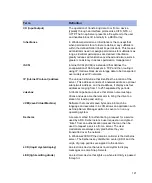
124 Snap Server Administrator Guide
POSIX (Portable Operating System
Interface)
A set of standard operating system interfaces based on the
UNIX operating system. The need for standardization arose
because enterprises using computers wanted to develop
programs that could run on multiple platforms without the
need to recode. The Snap Server uses Extended POSIX
ACLs.
protocol
A standardized set of rules that specifies the format, timing,
sequencing, and/or error checking for data transmissions.
public access share
A share that allows all users read/write access to the file
system.
quota
A limit on the amount of storage space on a volume that a
specific user or NIS group can consume.
RAID (redundant array of
independent disks)
A collection of disk drives that act together as a single
storage system. Different RAID types provide different levels
of data protection.
RAID 0 (Striped)
Distributes data evenly among all disks in the array. This
technique, called data striping, results in fast access speeds
because it uses multiple physical devices to store the data.
However, RAID 0 offers no redundancy and does not accept
hot spares. If a single disk drive fails, every file in the RAID
is rendered unavailable.
RAID 1 (Mirrored)
Stores data on one disk drive and copies it to another drive
in the RAID. A RAID 1 must contain at least two disk drives:
one for the data space and one for redundancy. Although
the data space in a RAID 1 can never be larger than a single
drive, some administrators prefer to add a third drive (either
as a hot spare or a member) for additional redundancy.
RAID 1 is the most secure method for storing mission-critical
data because there is no catastrophic data loss when a disk
fails. However, RAID 1 is the most expensive and least
efficient storage method.
RAID 5 (Striping with Parity)
Distributes data evenly among all disks in the array, and
maintains parity information (error correction data) that
allows the system to recover from a single disk drive failure.
RAID 5 provides the best combination of performance,
usability, capacity, and data protection.
recurring snapshot
A snapshot that runs at an administrator-specified time and
interval.
Term
Definition
Содержание 5325301638 - Snap Server 4500 NAS
Страница 2: ......
Страница 10: ...x Snap Server Administrator Guide ...
Страница 14: ...xiv Snap Server Administrator Guide ...
Страница 42: ...NIS Domain 28 Snap Server Administrator Guide ...
Страница 68: ...Setting File and Folder Permissions Windows 54 Snap Server Administrator Guide ...
Страница 96: ...Log View 82 Snap Server Administrator Guide ...
Страница 116: ...Phone Home Support 102 Snap Server Administrator Guide ...
Страница 148: ...134 Snap Server Administrator Guide ...











































